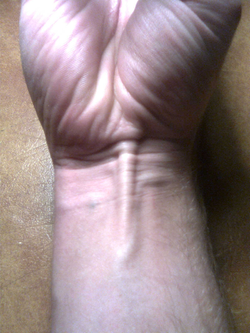
Palmaris longus muscle

The palmaris longus is a muscle visible as a small tendon between the flexor carpi radialis and the flexor carpi ulnaris, although it is not always present. It is absent in about 14 percent of the population; however, this number varies greatly in African, Asian, and Native American populations. Absence of the palmaris longus does not have an effect on grip strength. The palmaris longus is a muscle visible as a small tendon between the flexor carpi radialis and the flexor carpi ulnaris, although it is not always present. It is absent in about 14 percent of the population; however, this number varies greatly in African, Asian, and Native American populations. Absence of the palmaris longus does not have an effect on grip strength. The palmaris longus muscle can be seen by touching the pads of the fourth finger and thumb and flexing the wrist. The tendon, if present, will be visible in the midline of the anterior wrist. Palmaris longus is a slender, elongated, spindle shaped muscle, lying on the medial side of the flexor carpi radialis. It is widest in the middle, and narrowest at the proximal and distal attachments. It arises mainly from the medial epicondyle of the humerus via the common flexor tendon. It also takes origin from the adjacent intermuscular septa and from the antebrachial fascia. It ends in a slender, flattened tendon, which passes over the upper part of the flexor retinaculum and inserts onto the central part of the flexor retinaculum and lower part of the palmar aponeurosis. Frequently, it sends a tendinous slip to the short muscles of the thumb. The palmaris longus is supplied by the median nerve. The palmaris longus muscle is a variable muscle. The most common variation is its absence. Several in vivo and in vitro studies have documented the prevalence of absence of the PL tendon in different ethnic groups. Between 5.5 and 24% of Caucasian populations (European and North American) and 4.6 to 26.6% of Asian populations (Chinese, Japanese, Indian, Turkish, Malaysian) have been reported to lack the PL tendon. There are also variations related to its form. It may be tendinous above and muscular below; or it may be muscular in the center with a tendon above and below; or it may present two muscular bundles with a central tendon; or finally it may consist solely of a tendinous band. The muscle may be double, or missing entirely. Slips of origin from the coronoid process or from the radius have been seen. Partial or complete insertion into the fascia of the forearm, into the tendon of the flexor carpi ulnaris and pisiform bone, into the scaphoid, and into the muscles of the little finger have been observed. The palmaris longus muscle is the most popular for use in tendon grafts for the wrist due to the length and diameter of the palmaris longus tendon, and the fact that it can be used without producing any functional deformities. When a tendon becomes ruptured in the wrist, the palmaris longus tendon may be removed from the flexor retinaculum and grafted to take the place of the ruptured tendon. The tendons most commonly replaced or supplemented by the palmaris longus tendon when ruptured are the long flexors of the fingers and the flexor pollicis longus tendon.
